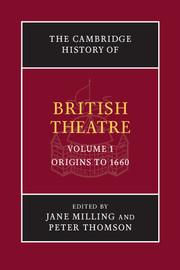Book contents
- Frontmatter
- PART I PRE-ELIZABETHAN THEATRE
- PART II ELIZABETHAN THEATRE
- 5 The development of a professional theatre, 1540–1660
- 6 Drama outside London after 1540
- 7 ‘An example of courtesy and liberality’: great households and performance
- 8 The birth of an industry
- 9 Theatre and controversy, 1572–1603
- 10 The condition of theatre in England in 1599
- 11 Ben Jonson's Every Man in his Humour: a Case Study
- 12 London professional playhouses and performances
- PART III JACOBEAN AND CAROLINE THEATRE
- Works Cited
- Index
- References
12 - London professional playhouses and performances
from PART II - ELIZABETHAN THEATRE
Published online by Cambridge University Press: 28 March 2008
- Frontmatter
- PART I PRE-ELIZABETHAN THEATRE
- PART II ELIZABETHAN THEATRE
- 5 The development of a professional theatre, 1540–1660
- 6 Drama outside London after 1540
- 7 ‘An example of courtesy and liberality’: great households and performance
- 8 The birth of an industry
- 9 Theatre and controversy, 1572–1603
- 10 The condition of theatre in England in 1599
- 11 Ben Jonson's Every Man in his Humour: a Case Study
- 12 London professional playhouses and performances
- PART III JACOBEAN AND CAROLINE THEATRE
- Works Cited
- Index
- References
Summary
On 21 January 1560, Queen Elizabeth's treasurer of the chamber recorded a payment to
The Lord Robert Dudley's players and to Sebastian Westcott, Master of the Children of Paul's… in way of the Queen's Majesty's reward for playing of Interludes before her highness at Christmas - to either [each] of them vj li xiij 8 iiij d .
There were at this time no permanent playhouses in London. The Children referred to – scholars and choristers – performed only occasionally and in private. The small groups of adult actors – around six men in each company – were attached to the households of some nobles but were, for most of the year, itinerant performers, performing where they could find a venue and, in London especially, constantly oppressed by civic authorities.
The first step in the adults' attempts to secure a foothold in London came in 1567, when John Brayne, a grocer from Bucklersbury, paid for a permanent playhouse to be erected in the suburbs of London – the Red Lion. Our knowledge of this project is derived entirely from the records of a dispute between Brayne and his carpenters. According to the details of the ensuing court case, the Red Lion was a ‘messuage or farme house’, and not, as was previously thought, an inn used, like other inns, as an occasional venue for plays. There, in the adjoining garden, Brayne erected what is so far as we know the first purpose-built playhouse in England, essentially combining a platform stage of the kind erected by travelling players with galleries for spectators such as those found in bearbaiting arenas and innyards.
- Type
- Chapter
- Information
- The Cambridge History of British Theatre , pp. 298 - 338Publisher: Cambridge University PressPrint publication year: 2004

